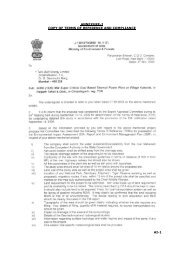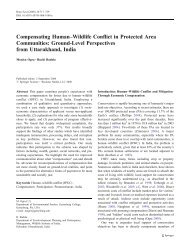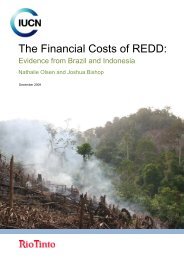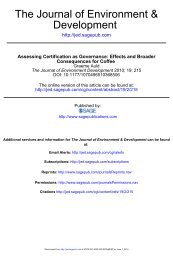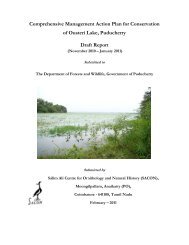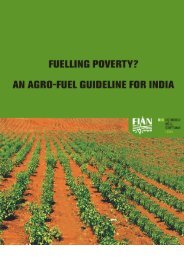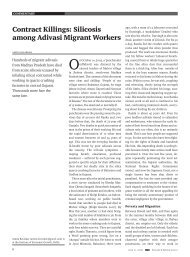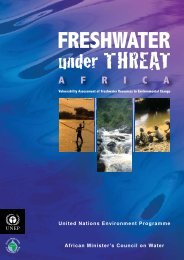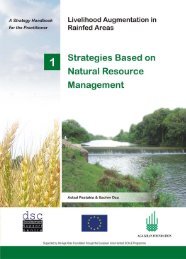Integrated River Basin Planning – Replicable ... - India Water Portal
Integrated River Basin Planning – Replicable ... - India Water Portal
Integrated River Basin Planning – Replicable ... - India Water Portal
Create successful ePaper yourself
Turn your PDF publications into a flip-book with our unique Google optimized e-Paper software.
<strong>Integrated</strong> <strong>River</strong> <strong>Basin</strong> <strong>Planning</strong>: <strong>India</strong> and the EU share experience on policy and practice<br />
Annex<br />
Annex 3<br />
Figure 11 The European Union (in 2008)<br />
<strong>Water</strong> and Environment Policies in the<br />
European Union<br />
The following two European cases illustrate how proper management of water data<br />
can assist in forming the basis for better decision making so that priority issues can<br />
be addressed.<br />
A3.1 Relevance of the EU context to <strong>India</strong><br />
The European Union presently consists of 27 sovereign countries with a total<br />
population of nearly 500 million people. The EU's member states cover an area of<br />
4.4 million square kilometres. In comparison, <strong>India</strong> consists of 28 states and three<br />
Union Territories with a total population of approximately 1.2 billion people (2.4 times<br />
the EU). <strong>India</strong> covers an area of 3.3 million square kilometres (0.75 times the EU).<br />
A3.2 EU context<br />
The European Union (Figure 11), tracing its origins to the European Coal and Steel<br />
Community formed among six countries in 1951 and the Treaty of Rome in 1957,<br />
was established in 1993 by the Maastricht Treaty, adding new areas of policy to the<br />
existing European Community. The EU generates an estimated 30 percent share of<br />
the world's nominal gross domestic product (USD16.8 trillion in 2007).<br />
The EU has developed a single market through a standardised system of laws<br />
which apply in all member states, guaranteeing the freedom of movement of people,<br />
goods, services and capital. It maintains a common trade policy, agricultural and<br />
fisheries policies, environmental policies and a regional development policy. The EU<br />
has grown in size through the accession of new member states and has increased<br />
its powers by the addition of new policy areas to its remit.<br />
The original Treaty of Rome did not provide for the environment as a joint policy area.<br />
In the 1970s, governments realised the increasing importance of joint policies and<br />
action on the environment. In this period, the major driver for environmental policy<br />
was environmental and public health. The mandate for introducing environmental<br />
policy at the European level was for many years found in the first treaty’s objective<br />
of establishing a common market and removing trade barriers and distortion of<br />
competition in the economic domain.<br />
As long as there was no such basis, the EU was required to base its environmental<br />
decisions on articles of the treaty that were not designed to be used as a basis for<br />
environmental policy making. As the EU’s environmental policy activity increased,<br />
so too did the need to have a proper framework within the treaty. This was achieved<br />
with the Maastricht Treaty of 1992 that changed the objective of EU<br />
to promote throughout the community a harmonious and balanced<br />
development of economic activities, sustainable and non-inflationary growth,<br />
respecting the environment ….<br />
The treaty also stated that<br />
Community policy on the environment should aim at a high level of protection<br />
taking into account the diversity of situations in the various regions of the<br />
community.<br />
The later 1997 treaty goes a step further referring to<br />
a high level of protection and improvement of the quality of the environment.<br />
<strong>Water</strong> is now the sector with the most comprehensive coverage in EU environmental<br />
legislation.<br />
A3.3 Overview of EU <strong>Water</strong> Policy and Legislation<br />
<strong>Water</strong> and water pollution were among the first environmental concerns in the EU.<br />
The first pieces of EU water legislation were accepted by the European Council<br />
as early as 1973. Since then, European water legislation has taken a leading and<br />
innovative role in the design of national water policy in many EU Member States.<br />
There have been two important periods of EU water legislation. The first period<br />
occurred between 1975 and 1980, resulting in a number of Directives and Decisions<br />
that either lay down water quality objectives for specific types of water (e.g. the<br />
72 73



